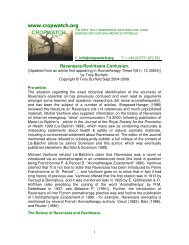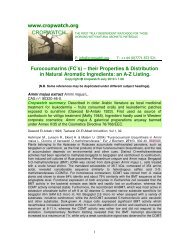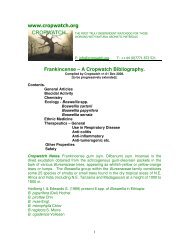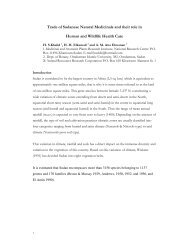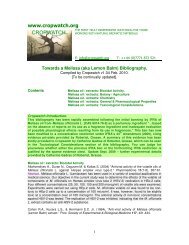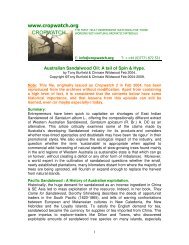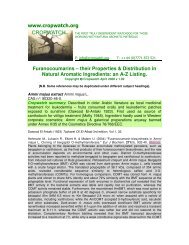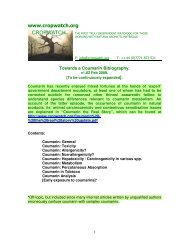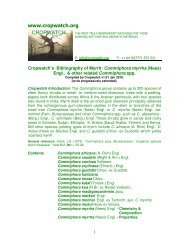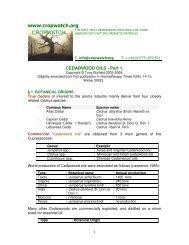Sandalwood Biblio - Cropwatch
Sandalwood Biblio - Cropwatch
Sandalwood Biblio - Cropwatch
Create successful ePaper yourself
Turn your PDF publications into a flip-book with our unique Google optimized e-Paper software.
Shankaranarayana K.H., Angadi V.G., Rajeevalochan A.N.,. Theagarajan K.S., Sarma C.R. &<br />
Rangas-wamy C.R. (1997). “A rapid method ofestimating essential oil content inheartwood of<br />
Santalum album Linn.” Current Science 72(4), 241-242.<br />
Shankaranarayana K.H., Rajeevalochan G., Rajeevalochan A.N. & Angadi V.G. (2005) "Fragrant<br />
oils from exhausted sandalwood powder and sandal sapwood." J. Sci.Ind. Res. 64, 965-966.<br />
Shukla B.V., Ravindra M., Shukla S.V., Lahire L. & Singh D.P. (1999) “Qualitative assessment of<br />
sandalwood oil using gas chromatography” PAFAI J. 13, 41-43.<br />
Sidheswaran P. & Ganguli S. (1997) "<strong>Sandalwood</strong> oil substitutes - A review" Supplement to<br />
Cultivation & Utilisation of Aromatic Plants CIMAP (1997).<br />
Spreitzer, H., Roesslhuber I, et al. (1990). “Structure/odor relationships of beta-santalol<br />
analogues: E-homo-beta-santalol and E-dehydrohomo-beta-santalol.” Monatshefte Fuer Chemie<br />
121(2-3), 195-202.<br />
Stappena I., Höfinghoff J., Friedl S., Pammer C., Wolschann P. & Buchbauer G. (2008)<br />
"Structure–activity relationships of sandalwood odorants: Total synthesis and fragrance<br />
properties of cyclopropano-β-santalol." European Journal of Medicinal Chemistry 43(7),1525-<br />
1529. Abstract. The synthesis and odor properties of cyclopropano-β-santalol, a new santalol<br />
analogue, are described. The exocyclic double bond of the original molecule, β-santalol, is<br />
replaced by a cyclopropane ring. Despite the analogies in the binding properties between the<br />
double bond and cyclopropane this change in the bulky hydrophobic part of the molecule leads to<br />
the complete loss of the characteristic sandalwood odor: in an olfactory evaluation the (Z)-product<br />
appears spicy and sweet, the (E)-isomer woody, but neither of them exhibits the typical<br />
sandalwood character.<br />
Graphical abstract:<br />
Verghese J., Sunny T.P. & Balkrishnan K.V. (1990) “-(-)-α-santalol & (-)-β-santalol concentration,<br />
a new quality determinant of East Indian sandalwood oil.” Flavours & Fragrances J. 5, 223-226<br />
Walker G.T. (1968) "The chemistry of the oil of sandalwood." Perf & Essen Oil Record 59(11),<br />
778-781.<br />
Wang Z. & Hong X. (1991) "Comparitive GC analysis of essential oil in imported sandalwood"<br />
Zongguo Zong Yuo Za Zhi 16(1), 40-43, 64. Abstract: The GC-fingerprint spectra of essential oils<br />
in imported sandalwood are established by the new technique of GC-relative retention value<br />
fingerprint spectrum (GC-FPS). According to the GC-FPS of samples, their chromatographic<br />
peaks, overlap ratio of peaks and eight strong peaks are studied comparatively.<br />
Witteveen J.G. & van der Weerdt A.J.A. (1987) "Structure-odour relationships of some new<br />
synthetic sandalwood aroma chemicals - Synthesis and olefactive properties in a series of bicyclo<br />
[4.4.0] decan-3-ols. Rec Trauvase Chim., Pays-Bas 106, 29<br />
General Articles – E.I. <strong>Sandalwood</strong>.<br />
Adkoli N.S. & Kushalappa K.A. (eds)(1977) Proceedings of All India Sandal Seminar, Bangalore,<br />
7-8 February, 1977. Myforest, Special Issue. pub Karnataka Forest Dept, Bangalore.<br />
Ananthapadmanabha H.S. (2000) “The present status of sandalwood in India & Australia” PAFAI<br />
Journal 2, 33-36.<br />
Ananthapadmanabha H.S. (2000) “<strong>Sandalwood</strong> and its marketing trend.” My Forest 36, 147-151..<br />
38





